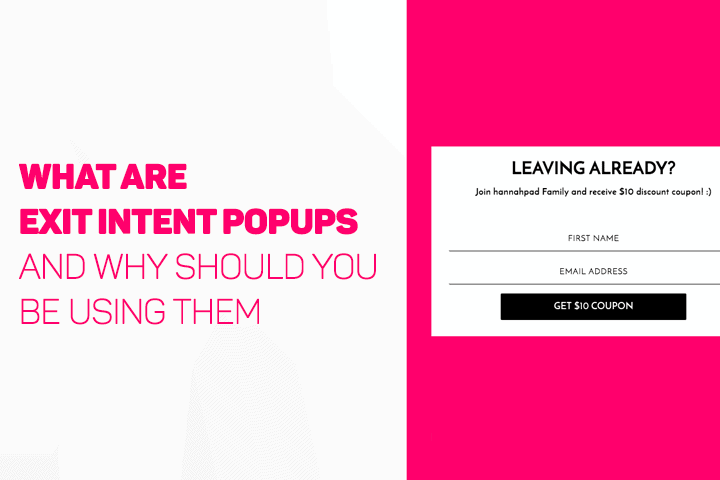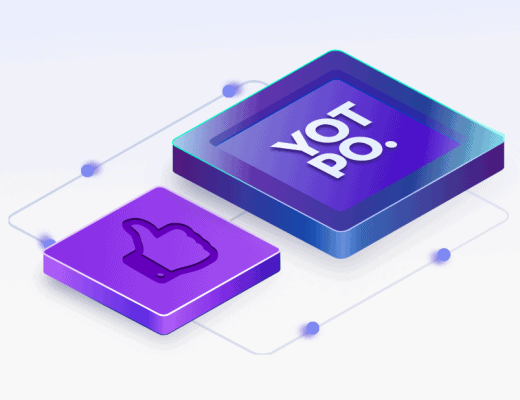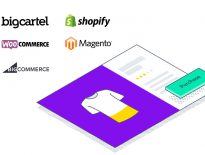Have you heard about exit intent? If not, and you are in the field of digital marketing, then you should seriously consider learning about this field and the opportunities it can bring if handled correctly.
So, what exactly is exit intent? To put it simply, exit intent is when the user or visitor of a website navigates the site with the intention of exiting or leaving. In other words, they are just about to go back or close their browser. Now, previously digital marketers could do little about this, however a fairly new field of marketing, as well as the technology to power it, provides the opportunity to detect exit intent (i.e. when the business is about to lose a customer) and then quickly take action to catch their attention one last time. This might be a special offer to stop you leaving, or a suggestion to buy a product you were previously browsing. The most common method of handling exit intent correctly for marketers is exit intent popups.
Let’s take a look at these.
At its core, a popup is a webpage overlay with a message which appears on the website during browsing, often thought of in conjunction with spammy ads that used to popup on sites in the early 2000s. But, exit intent popups are different and designed to be targeted to the user, but also trigger only as visitors attempt to navigate away of a page. It is mainly used in webpages to attract the visitor’s attention before they leave the page, presenting a final offer that may entice the visitor to use the webpage owner’s offered services, or buy some goods sold through the website. It is not assertive or annoying as it only appears once a visitor attempts to exit the page. It can also serve as a reminder to visitors about your offered good or services in case they accidentally attempted to exit your webpage, which helps in retaining potential customers. However, exit intent popups are a double-edged sword. It can either be beneficial or detrimental to you, depending on how you do it. According to Neil Patel, a famous digital marketing expert and co-founder of Crazy Egg (a company that helps in improving your website instantly, according to their website), if you use it wisely, exit intent popups can help digital marketers increase their conversion rate and reduce bounce rate.
But, how exactly do exit intent popups function? Well, as stated previously, exit intent popups appear when visitors attempt to leave the page. So, to know when exactly should these appear, the technology uses algorithms to perform behavioral analysis on the visitors which helps in determining when the user intends to leave the webpage. These popups then appear as a visitor moves the mouse pointer close, or hovers it above, the exit icon of the browser page.
So, why exactly should you use exit intent popups on your website? To answer that, let us look at the advantages they bring:
Exit intent popups are less intrusive than time-based popups
Time-based popups take up your time as you wait for them to finish before you can proceed using the website. Those are precious seconds lost on something the users or customers may not necessarily need or enjoy.
It serves as a sales pitch
Let us say a user may have arrived at your webpage accidentally or randomly. Assuming the user does not really know your website, thus would like to close your page without the intention of using it, then the exit intent popup will be useful in showing a glimpse of what the services or goods offered on your site are. This may then pique the interest of a random user, who in turn will continue browsing your page, essentially becoming a potential customer when previously they would have bounced.
It is effective without being too detrimental
It is only a brief interruption and worth only a single look, thus the page visitors would not be wasting too much time even if it is irrelevent. Some visitors may still think it is an annoyance, especially impatient ones, but you have to take the good with the bad. Also, that is the reason why you should be strategic in what the messaging in your popup is. Make sure it coincides with what visitors may want to get from your websites, and not random things that do not have any relation to your brand’s offerings. Be precise and on-point.
It can sweeten or even result in a sale
Exit intent popups should coincide with what the user was doing in your website. Let us use shopping for mobile phones as an example. Your website is selling multiple brands of cellphones, but the user was mainly looking at one brand. He or she looked at multiple models from the same brand, and was yet to decide. The user then opens another window and looks at offers from another website. He or she may have then decided that the other site has a better deal. A popup as the user intends to exit your page would be useful in proposing a deal that may improve the chances of securing a deal, like 10% off for new orders for example. In your popup, you may provide discount coupons which may sway the visitor to choose a product offered in your website instead.
It can help in building brand relationship with previous customers or current visitors
One way exit intent popups are used is to capture information about the visitor. Before visitors or customers leave your webpage, use a popup to pique their interest regarding the purpose of their visit, and ask them for their email addresses, which will then be added to your email list. This way, you can establish contact with the visitor, making them potential customers in the future, or re-engage with previous customers that will help to remind them of the existence of your website which they have previously used for its goods or services.


Exit intent popups, as stated above, is a beneficial tool you can use to your advantage. However, as also said previously, it can also be detrimental if used wrongly. How then can it be used properly to reap its advantages and avoid making it disadvantageous to your website? The following are some examples of how it can be used effectively:
Use it to give the best choices you can currently offer to the website visitor
A visitor may be overwhelmed with the choices they have with the goods or services you offer. These may then cause confusion to them and instead make them not buy from your website or use any of your service. Use a popup then to present a goods they are targeting that may be currently on sale, or a service that you are currently providing on discounted price. This will help in limiting their choices and increase the chance of making a deal.


Use it to remind the customer about items in their cart
Especially for online selling webpages, some users add items that they are interested in to their digital carts, but may later forget or lose interest in those items in their cart as they see another item they are interested to have that is found in other websites. So, before the user can exit from your webpage, use a popup to remind them about the items currently in their cart, which may then pique again their interest on those items. These will reduce cart abandonment.


Use it to reiterate or reintroduce offers that were shown in the landing page
Some users may have forgotten promos or coupon codes that have been shown when they first landed in your page, so use exit intent popup to remind them about it. This, in turn, may increases the chances of securing a potential deal, especially if there would be a product the user is interested in that is included in the promo or can be bought using the coupon codes.
Use it to entice users to come back in the future
Use a popup to ask for the email address of the user so that you can send them offers right to their emails. This will give them the option of using your services or buy from you in the future instead. Also, this will help in having a bigger pool of potential customers, instead of losing one right on the spot.
Use it to warn users about consequences of leaving the site
Some people use some websites for important purposes, and loss of information may occur if websites are accidentally closed. Use of popups in this case will alarm the user of the potential loss which then helps prevent such accidents from occurring.
A popup will appear that will help the user directly locate a specific item or services they might be interested in based on their behaviour as they used the website.
Use it to collect specific information
Popups can also be used to collect other information aside from email addresses. You can use it for polling, or for profiling, or for anything you want, as long as users are willing to provide the information asked. Using a popup as a questionnaire is a great way of taking advantage of the uses of exit intent popup.


Use it to provide price or availability alerts
Some commodities frequently change in their availability or price, such as housing, land properties, plane tickets, job positions, etc. Using a popup to provide current status of these commodities will make visitors glad for the timely update, instead of being irked by a popup.


The success of these examples lies mainly with two reasons: 1) the page visitors are only presented with their targeted interests based on their behavior when they used the webpage and 2) these interests are then converted to offers that can help prevent the visitors from leaving, which increases the chances of making that sale.
These are just some of the ways exit intent popups are used currently in digital marketing. However, this does not mean you should limit yourself to using just these methods. You can be creative and find other ways you can use them that work for your brand. The great (and frustrating) thing about digital marketing is that certain things work for some brands while other techniques fail. The key is testing and tracking the data so you can see what works for your business.







